Hamster vs guinea pig may be the hardest decision any wannabe pet owner could make. How do you choose between the two cutest pets in the world? We understand you completely.
Hamsters and guinea pigs tend to look similar to the untrained eye. But, to an animal lover the difference between hamster and guinea pig is quite clear. While both are small, hamsters are smaller and more solitary. Plus, guinea pigs are more likely to live in pairs or even groups. They also live reasonably longer than hamsters do.
Which one is right for you depends on your own circumstances, so let’s look at more detail.
Hamster vs Guinea Pig
Obviously, when it comes to choosing the right small pet there’s no one animal that is universally more suitable for everyone.
Worrying about making the right choice is often a big part of bringing home a new pet. Especially if it’s your first pet. This is a great sign that you’re taking pet ownership seriously, and are committed to giving your new friend the best life possible!
Guinea pigs and hamsters both have loads to offer, and either can be a rewarding addition to your family.
But to help you decide between a Hamster and a Guinea Pig, in this article we are going to look at:
- The difference between a Hamster and a Guinea Pig
- The history of Hamsters and Guinea Pigs
- Size and appearance of Hamsters and Guinea Pigs
- Hamster vs Guinea Pig temperament
- Taming and socializing a Hamster or Guinea Pig
- Hamster vs Guinea Pig housing
- Caring for a Hamster
- Caring for a Guinea Pig
- Feeding a Hamster or Guinea Pig
- Hamster and Guinea Pig health
- Can Hamsters and Guinea Pigs live together
- Hamsters eat Guinea Pig food?
- Can Guinea Pigs eat Hamster food
- Hamster vs Guinea Pig for children
- Pros and cons of a Hamster vs Guinea Pig
To begin, let’s look closely at the differences between a hamster and guinea pig.
What Is the Difference Between a Hamster and a Guinea Pig?
In practical terms, the biggest difference between hamsters and guinea pigs is how much space they take up in your home.
Hamsters usually prefer to live alone. We believe solitary hamsters need at least a 30 gallon tank, but this will easily sit on a small side table or in the corner of a desk.
Hamsters are enthusiastic diggers, but a tank will easily keep their sawdust trapped. That way, you don’t find evidence of their excavations all over the floor.
Meanwhile, guinea pigs are not only bigger, but need to be kept in pairs or herds. Besides their size, guinea pigs, unlike hamsters, are fully domesticated. So, the guinea pigs you see at the pet shop? Those do not exist in the wild at all.
The History of Hamsters and Guinea Pigs
It turns out the absolute worst way of choosing between a hamster and guinea pig is by conducting a poll of other pet owners.
Why?
In 2012, American Veterinary Medical Association figures showed that 877,000 US households owned a pet hamster. Meanwhile, 847,000 households kept guinea pigs. And guinea pigs have been rapidly gaining on hamsters since the last survey in 2007.
So as a nation, Americans are split right down the middle between guinea pigs fans and hamster lovers!
To find out why both camps love their pets so much, we need to look closely at their histories.
The Origins of the Hamster
It’s been nearly a century since we started keeping hamsters as pets.
These rodents are compact, cute, and usually easy to tame. It’s not hard to see why they became a popular pet in this time, especially with children.
Hamsters originally came from Aleppo, Syria. They were brought into Jerusalem in about 1930 by a zoologist named Israel Aharoni. There in Jerusalem, the hamsters were bred with much success. Eventually, they were essentially exported to the US where they were useful for research in laboratories.
We’re probably most familiar with the cuddly Syrian hamster, but things are changing. There are now several dwarf varieties also widely available at pet stores. At this point, choosing the right hamster and giving it the right care is an article in it’s own right.
Fun fact: A group of hamsters is known as a horde.
The Growth of the Guinea Pig
Guinea pigs have been kept as pets for as long as hamsters. But until recently, they were a much less common choice among pet owners.
These cute, cuddly creatures were first seen in South America, as early as 5000 BC. They were bred for food initially. There are a ton of stories about the various roles guinea pigs played in the past. Some folk lores say they were exchanged as gifts, while others say they were used in rituals to cure illnesses like arthritis.
Eventually, guinea pigs were brought over to Europe where royals like Queen Elizabeth I bought them as pets.
Now they’re coming into the limelight more and more and it’s no surprise. Still round, still fluffy, and still easy to handle, but a bit more substantial than a hamster.
As mentioned earlier, there’s only one species of domesticated guinea pig. However, there’s certainly a kaleidoscope of colors and coat types to choose from.
For an in depth look at guinea pigs alone, check out our complete guide to guinea pigs as pets.
Hamster vs Guinea Pig Appearance
Syrian hamsters are a palm-sized 5-7oz (140-200g), and dwarf breeds are even smaller, only reaching 1-2.5oz (30-70g).
Guinea pigs meanwhile typically weigh between 1.5 and 2.5 lbs (700 to 1,100g).
So they’re built on a different scale, but their physical characteristics are quite similar.
Both are irresistibly chubby-looking, with big round eyes and petal ears. Neither have tails to speak of. Yet, as you’ll see in their appearance, hamsters are more closely related to rats and mice than guinea pigs are.
You can also find long-haired and short-haired hamsters and guinea pigs, not to mention curly haired and silky varieties.
Hamster vs Guinea Pig Temperament
A lot of us want a pet so that we can hold it and play with it.
So if you’re looking for a pet which gives something back, would you be better off with a hamster or a guinea pig?
Both guinea pigs and hamsters will relax into being held and stroked if they are handled regularly.
But because hamsters are solitary by nature, they do tend to have a shorter patience threshold. It won’t be long before they demand to be put down again.
Guinea pigs are different, though. If you’re looking for small talk, a 1976 study in the UK found that guinea pigs make 11 distinct call types. We can hear and use these to understand what they’re thinking and feeling.
So, once you’re familiar with each other, guinea pigs often have plenty to say to their humans.
Hamsters, in comparison, tend to have a lot to say to each other. However, their vocal range is largely outside our range of hearing, so we don’t get the pleasure of hearing what’s on their minds.
Thankfully, chit chat isn’t the only way of interacting with your pet.
Grooming is another great way to share time with your pet. Long-haired varieties of hamster and guinea pig are certainly a bigger daily commitment, but that time together is perfect for developing a bond.
And finally both hamsters and guinea pigs both love exploring, which gives us humans a chance to have fun by adding adventure into their lives.
Constructing new hideaways for treats or connecting cardboard boxes and tubes to build new tunnels is a great way for kids (and adults!) to interact with both hamsters and guinea pigs.
Taming and Socializing a Hamster or Guinea Pig
The whole idea of keeping pets is to socialize with them. So it makes perfect sense that you’re wondering how to tame a hamster. Or how to tame a guinea pig — whatever the case may be. Let’s talk about taming and socialization. This is another area that highlights the difference between hamster and guinea pig
Taming and Socializing a Hamster
Is it easy to tame a hamster? How do you tame a hamster? These are a few of the questions we’re about to answer. First off, should we be concerned about taming or socializing a hamster? Yes, some hamsters may need to be tamed because at first hamsters may be unaccustomed to people.
When you first get a pet, you’re basically a stranger to them, so it’s only fair that you give them time to adjust. Also, where you get your pet from could determine the level of taming your hamster will need. Good breeders tend to start holding the babies at a young age, whereas pet shops may not have the time or concern to tame their animals.
But, do hamsters bite? Yes, hamsters can bite. But not every hamster will bite. Typically, they’ll bite because they’re afraid or feel threatened. They may also bite when their teeth are overgrown.
Be patient with them. You may need to use thick gloves to handle them in the meantime. But try to feed and pet them and bond with them.
3 Steps to Socializing Hamsters
So again, it comes back to helping your hamster feel comfortable. How can you do this? Remember these three steps:
- Ease them into it: We want our pets to love us immediately, but hamsters need time. You may need to place them in a low-traffic area of your home so they slowly adjust to human presence and contact. Also, try not to disturb them while they’re asleep. Hamsters have poor eyesight, so they’ll need to learn your scent. Start socializing them by placing your washed hand inside the cage. Don’t try to grab the hamster yet.
- Hold your hamster: At first, you may need to entice your hamster into your palm using a treat or two. Continue to offer them your hand and a treat daily until your hamster comes over and sniffs your hand. Again, do not try to grab the hamster. Eventually, after two to three more days, your hamster will climb into your hand. But, once they get comfortable, pet them as much as they’ll allow while talking to them in a soothing voice.
- Let them explore their surroundings: As they start to feel at home, they’ll want to explore everything from your arms to items in their cage. Let them.
Taming and Socializing a Guinea Pig
Guinea pigs are much friendlier and social creatures and do not need as extensive taming. Still, they may need time to adjust to your presence and home. It’s important to be gentle with them and avoid loud noises which may scare them, especially at first.
The four most important steps for taming a guinea pig are as follows:
- Establish familiarity using a treat: Talk softly to your guinea pig as you offer him a treat. At this stage, do not make contact unless they’ve come to you.
- Develop trust: By repeatedly offering treats multiple times a day. When they eventually associate you with food, they’ll be coming to you for it!
- Pet your guinea pig: Now that you’re becoming besties, feel free to gently pet your guinea pig.
- Hold your guinea pig: Once they’re comfortable being petted, you can go one more step. Pick up your guinea pig and hold them. Remember not to squeeze, though!
You can view our complete article on taming a guinea pig here.
Hamster vs Guinea Pig Housing
Housing Hamsters
Hamsters need a cage that with space that is be at least 19 x 19 inches square and 6 inches high. Their cage must have a solid floor, not mesh, as this can injure your hamster’s feet. You may provide either a wire, glass or plastic cage.
Wire cages are great because they tend to be well ventilated. Just make sure the bars are 1/2 to 3/4 inch apart, max. This is because hamsters can slip through any spaces as long as they can fit. The ideal wire cage should also have a base that can be detached for easy cleaning.
Glass cages, on the other hand may be poorly ventilated while plastic cages are usually harder to clean. So, we’d recommend wire cages. You can learn more about hamster cages and see our recommendations here.
Hamsters also need a nesting box, exercise wheel, food dish, and a water bottle in the cage. For their bedding be sure to make it deep, since they love to burrow. You can use recycled paper pellets and wood shavings, preferably aspen.
You’ll also need to change the bedding weekly.
Aspen is preferred because some pets may become sick when exposed to bedding containing phenols. These aromatic oils are often found in pine and cedar bedding, so avoid those.
Temperature wise, hamsters thrive at between 68 – 75 degrees Fahrenheit. Below 60, they may become less active and enter hibernation.
Housing Guinea Pigs
As social creatures, it’s best to house guinea pigs together. However, you might find this guide helpful if you have just one or more than two guinea pigs:
- One guinea pig: 7 square feet is the minimum you should provide for a single pig.
- Two guinea pigs: Aim for anywhere from 9 to 11 square feet, the larger the better.
- For more than two guinea pigs: add an extra 2 to 4 square feet per pig.
Guinea pigs cannot jump, so a height of 12 to 18 inches is fine to maintain good ventilation. As with hamsters, the cage should also have a smooth base to protect their feet. It is recommended to stick with wire bars again, as guinea pigs can and will chew through plastic or wood.
If you do decide to use wood, though, stick with safe wood such as oak, cherry, apple, aspen, linden, poplar, basswood and fir. This way, your piggy can chew through and still be fine. However, you’d need to keep monitoring the cage perimeter to see that there’s enough home left.
You can see our picks for best wooden guinea pig cages here. For other cage styles and full sizing guide, see this article here.
Indoor vs Outdoor Guinea Pig Housing?
Overall, though, guinea pigs are larger and will need more space than hamsters. For most people this means having a yard, and space for an outside hutch.
As we discussed, indoor cages are available, but you’ll need plenty of floor space. You also need to have a laid back attitude to the “scatter zone” of sawdust which ends up outside the cage.
And because they’re bigger, guinea pigs can’t get all the exercise they need inside a hutch. So, you’ll also need additional indoor or outdoor space. That way, they can run around for several hours a day.
Also, since guinea pigs are from cool climates, they don’t do well in hot, humid conditions.
Caring for a Hamster
Usually hamsters do not need much grooming because they tend to keep themselves clean and tidy.
For instance, short-haired hamsters may only need to be run through your hands to shine up their coats. You could also use a small soft brush. But that’s likely unnecessary and your hamster may not like it.
For long-haired females, their fur can become matted around the rear end. They may need you to tease it out using a fine comb.
Exercise for Hamsters
Something many people ignore with hamsters is the need for exercise. It is crucial that your hamster has the chance to exercise daily. They need a wheel to run in. But this wheel must be big enough so that your hamster does not have to bend inside. It should also have a solid floor instead of rungs which could injure the feet.
On average, many hamsters tend to exercise for 3 – 4 hours per night.
Also provide items like tubes, tunnels and small cardboard boxes in the cage for play. Chew toys like twigs of willow, beech or hazel are also great for climbing. Finally, hiding food and treats will motivate your hamster to forage — no room for boredom!
See our favorite hamster toys here and here.
- Hamster balls
- Hamster toys
Hamsters and Other Pets
It may not be safe to keep your hamster with other pets such as cats and dogs. Traditionally, these animals prey on hamsters. Unless you can secure an animal-proof cage for your hamster and always watch out for it, we would not recommend having a hamster and other pets.
Caring for a Guinea Pig
Guinea pigs require a different kind of care than hamsters do. In certain ways, they’re easier to manage, and in other ways, more taxing. For example, while hamsters tend to groom themselves, guinea pigs require more grooming.
Their nails should be regularly trimmed — every 8 to 12 weeks. While trimming, be careful to avoid cutting the quick, which marks the living part of the nail. Use a small animal nail clipper.
You also need to brush their fur every week. However, if your guinea pig has long hair, it may need more brushing to prevent matting.
Thankfully, they seldom require baths. But every 3 to 12 months — as your pet needs — you may bathe them. It is best to use a shampoo specifically for small animals, as human shampoos will dry them out.
Use a shallow bowl of warm water and watch out for their eyes and eyes; you don’t want to get shampoo in there. Dry them right away to prevent chills.
Exercise for Guinea Pigs
While hamsters need exercise equipment, guinea pigs just need space to roam. Exercise equipment like those of hamsters is often bad for guinea pigs’ backs and can cause real injury. So, stick to letting them walk around in their cages of out once in a while.
Guinea Pigs and Other Pets
Should your guinea pig meet your other pets? It depends. Yes, guinea pigs are very social and may want to get along with other pets. But they’re still prey. Your cat and/or dog may not know what to make of your guinea pig.
So make sure they only have supervised interaction. Keep the guinea pig locked away when other pets are around. And, only let it out when they’re away. Of course, everyone else in your family should know this.
This will prevent accidents and injuries to your piggy.
Nocturnal Pets
Hamsters are nocturnal animals. So, this means that they’ll be active mostly at night. They spend most of the daytime period asleep. Around 8 pm, when your kids are settling into bed, your hamster will be waking up.
So, does this mean a hamster would be guaranteed to be noisy at night? Not if you play your cards right. First off, you should not try to change your hamster’s sleep pattern — just not a kind or good idea. How then can you work around this?
-
- It helps to keep the cage somewhere far from your bedroom.
- You should also try to play with your hamster before bed to tire him out.
- Look for a wheel that can be silent and invest in chew toys as well.
All of these will keep your hamster active at night and help you sleep well.
In comparison, guinea pigs are not nocturnal and will largely go to sleep when you do.
Feeding a Hamster or Guinea Pig
Guinea pigs are herbivores. This means that they eat plants. Guinea pigs are happy just to munch on Timothy hay, and leafy greens like lettuce, parsley, and cilantro. They also eat pellets and are cecotropes — they eat their poop.
Still, you have to feed them a daily vitamin C supplement, whether in tablet or liquid. This is because guinea pigs do not make vitamin C on their own.
Hamsters, on the other hand, are omnivores; they eat plants and animals — often insects.
They also enjoy foraging and hoarding food, so they’ll love it if you hide food around their cages.
Hamsters should be fed daily — they enjoy a balanced, coarse mix of ingredients. This may include alfalfa, maize, wheat, beans, peas and sunflower seeds. They also need a high amount of protein in their diet, so don’t be afraid to leave them food.
Hamster and Guinea Pig health
Finally, in terms of lifespan, hamsters typically live two to three years. Dwarf species tend to live a little shorter, on average.
Guinea pigs meanwhile typically live around five or six years, although many survive longer. If they are properly cared for and fed, guinea pigs are generally healthy.
Although, just like any other pet, they can be prone to specific diseases, these can be prevented by medical check ups. Guinea pigs are prone to dental disease and bladder stones.
Hamsters on the other hand are prone to congestive heart failure at an early age — about six months old, in some cases. It is expensive to manage this condition and it is incurable. They can also suffer from an incurable kidney disease called amyloidosis.
Because they’re prone to dangerous bacteria, the main threat to hamsters are other hamsters or mice. Especially if they’re in a pet shop where infectious disease is more common.
Lastly, they also have dental issues like the guinea pig. Their incisors are constantly growing. So if they break, injure them, or develop an infection, these teeth may overgrow.
So, try to check your hamster’s front teeth every week. From a young age, train them to expect to be checked. Just lift their lips gently and check the symmetry, color, and length of the teeth. Don’t forget to treat them after!
Can Hamsters and Guinea Pigs Live Together?
Guinea pigs and hamster are both popular pets, so you might already have one and be thinking of getting the other.
Or you might already have both and wonder about keeping a hamster and guinea pig together.
Don’t.
Not only are their dietary requirements and space needs very different, but hamsters are fiercely territorial. They’re also conditioned to fear anything big enough to eat them in the wild.
This means putting hamsters and guinea pigs together would be enormously stressful for the hamster.
Hamsters are quick to bite when they feel threatened by a larger animal, and guinea pigs will bite back in self defense.
Owing to their difference in size, this is likely to cause a great deal of harm to the hamster, if not kill it.
In all probability, the guinea pig will end up injured too.
Can Hamsters and Guinea Pig Live in the Same Place, But Separately?
While this may be possible, you should be prepared for the expense. As we’ve seen, they will need separate cages, food, toys, and perhaps areas of the house altogether.
Can Hamsters and Guinea Pigs Play Together?
Again, this is unlikely to end happily.
If there is more than one human at home, you could try sitting next to one another holding a guinea pig and a hamster. But really, anything more than looking at each other from a distance is likely to be incredibly stressful for your hamster.
Watch out for signs of either animal becoming agitated and break contact immediately.
Can Hamsters Eat Guinea Pig food
As we’ve discussed, hamsters and guinea pigs while similar, have different dietary needs. Hamsters are omnivores, whereas, guinea pigs are herbivores. More information on the topic is available in this article.
So, we would discourage against feeding your hamster guinea pig food as such food isn’t meant for them.
Can Guinea Pigs Eat Hamster food
No, guinea pigs should certainly not eat hamster food. Guinea pigs need a large portion of fruits and veggies. They also benefit from vitamin C supplements. Hamsters have vastly different nutritional requirements. Therefore, guinea pigs should not eat hamster food.
Hamster vs Guinea Pig for Children
Hamsters have been a popular childhood pet for generations.
They’re a fairly modest commitment in terms of time, money and space, and they always live inside the home, so children can look at them whenever they like.
However they’re nocturnal, which can be disappointing for young children if their waking schedules don’t overlap.
Guinea pigs are a bigger commitment, but they are most active in the mornings and evenings, when children are likely to be home.
Guinea pigs are also less likely to bite than hamsters, preferring to wriggle away from a situation they don’t like.
Critically, helping look after pets is a fantastic experience for children, but responsibility for animal welfare always ultimately lies with a grown up.
The best pet for your children is one that YOU want and YOU are happy looking after.
What about choosing a hamster or guinea pig for teenagers?
As our kids get older, we reasonably begin to expect that if they want a pet, they will look after it.
This could give hamsters an edge over guinea pigs, because they are a gentler commitment. That said, anyone will lose motivation to care for a pet if it wasn’t the pet they wanted.
Hamster vs Guinea Pig Allergies
Human allergies to hamsters and guinea pigs are very rare. However, some people are allergic to guinea pigs. So, it’s still worth checking that no one in your home is allergic.
Pros and Cons of a Hamster vs Guinea Pig
Now let’s look at all the pros and cons in one place. This may help you decide which of these adorable pets is best for you.
Hamster Pros:
- Easy to groom
- Small living quarters required
- Less of a financial commitment
Hamster Cons
- Nocturnal and may be noisy without the right equipment
- Short lifespan
- Prone to incurable health conditions
- May be difficult to tame; may bite
- Requires more toys and exercise
- May not play well with other pets or hamsters
Guinea Pig Pros
- Very social and easily socialized
- Longer lifespan
- Fewer health issues
- Needs fewer toys and less exercise
Guinea Pig Cons
- Thrives in a group or with company; you may need a second guinea pig
- Needs a larger space
- Requires more grooming
- May require more attention
Hamster vs Guinea Pig Summary
We’ve highlighted that hamsters and guinea pigs do seem similar to some people. But now that you’ve seen the difference between hamster and guinea pig, you can’t “un-know” it.
These two round, cute, and fluffy mammals are different in size, for one. Guinea pigs are bigger. They’re also more social, less likely to exercise, and in need of more grooming than hamsters. Hamsters love to forage and will eat insects and plants, unlike piggies who only want plants.
So which one works for you? Remember that kids may lean toward more social guinea pigs. Guinea pigs also need more space, but are less likely to bite than hamsters will. Still, hamsters are nocturnal creatures who may demand slightly less attention, especially during the day.
The choice is yours, but we hope we’ve helped you realize which mammal works best for you.
Do you have a Hamster or Guinea Pig? We would love to hear all about them in the comments below.
References and Further Reading
-
- American Veterinary Medical Association
- Berryman, JC. 1976. Guinea pig vocalizations: Their structure, causation and function Ethology
- Fritzsche, Peter. 2008. Hamsters: A Complete Pet Owner’s Manual. Barron’s Educational Series Inc., NY ISBN 0-7641-3927-4.
- Spruce Pets. McLeod, L. DVM. How to Train Your Hamster to Be Tame.
- Humane Society of the United States. Is Guinea Pig the Right Pet for You?
- Pet Coach. Drs. Foster & Smith. Housing and Environment for Hamsters.
- RiverForest Veterinary Center. All About Hamsters.
- MSD Veterinary Manual. Quesenberry, K., E., DVM, MPH, DABVP. Routine Health Care of Guinea Pigs.
- RSPCA. Guinea Pigs: Good Practices for Housing and Care.
- WikiHow. Elliott, P., MRCVS. How to Keep a Guinea Pig Safe Around Other Pets.
- The Royal Society Publishing. Gatterman, R., Johnston, R., et al. Golden hamsters are nocturnal in captivity but diurnal in nature.
- VetStreet. Hess, L., DVM, DABVP. 10 Reasons Why Guinea Pigs Make Great Pets.
- PETA. 9 Facts You Need to Know Before Considering a Pet Hamster.

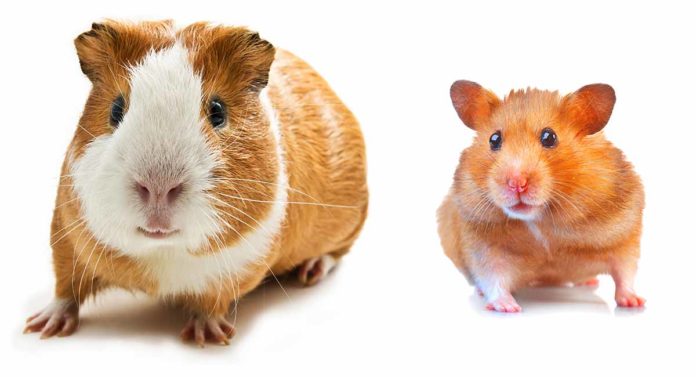
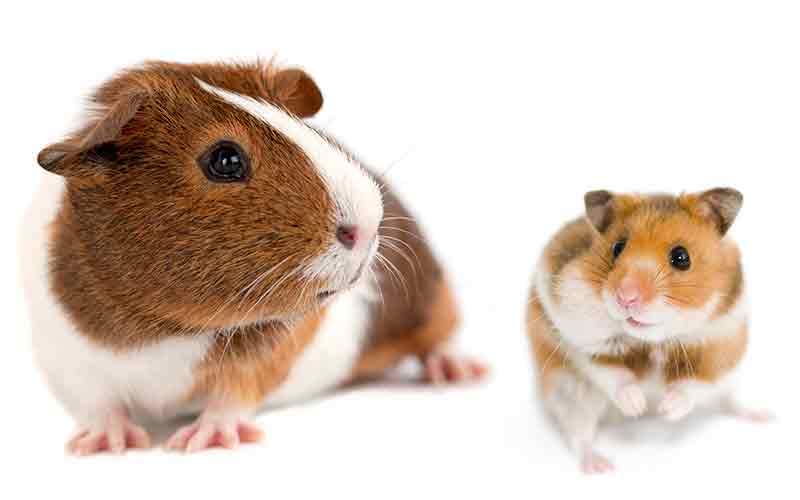
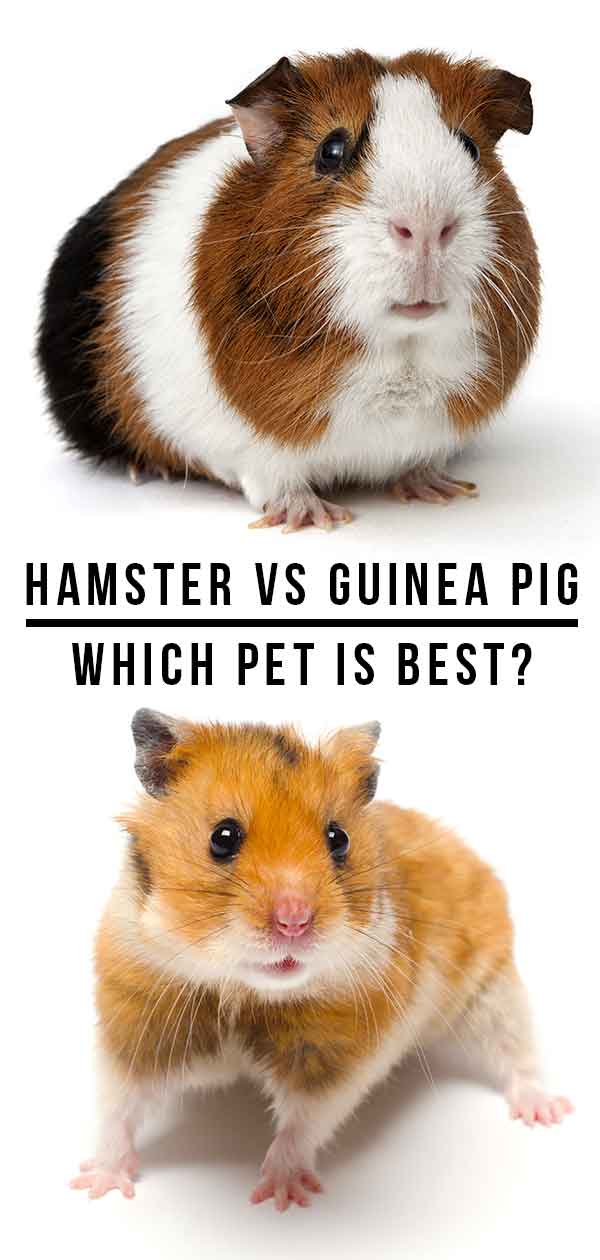

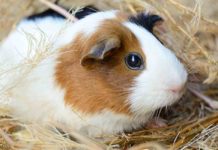
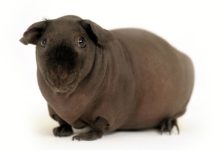











Team Guinea pig! They’re the best!
Guinea pigs win hands down
I am so on guinea pigs team i am trying to get one myself
I have both pets.they get mad wen I pet one an other😂❤️.I love both of them equally 🤪🥺and we’ll always